List of birds of North America (Charadriiformes)
Thick-knees
Order: Charadriiformes Family: Burhinidae
The thick-knees are a group of largely tropical waders in the family Burhinidae. They are found worldwide within the tropical zone, with some species also breeding in temperate Europe and Australia. They are medium to large waders with strong black or yellow-black bills, large yellow eyes and cryptic plumage. Despite being classed as waders, most species have a preference for arid or semi-arid habitats.
- Double-striped thick-knee, Burhinus bistriatus LC
Lapwings and plovers
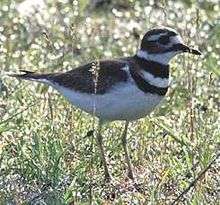
Order: Charadriiformes Family: Charadriidae
The family Charadriidae includes the plovers, dotterels and lapwings. They are small to medium-sized birds with compact bodies, short, thick necks and long, usually pointed, wings. They are found in open country worldwide, mostly in habitats near water.
- American golden plover, Pluvialis dominica LC
- Black-bellied plover, Pluvialis squatarola LC
- Collared plover, Charadrius collaris LC
- Common ringed plover, Charadrius hiaticula LC
- Eurasian dotterel, Charadrius morinellus (A) LC
- European golden plover, Pluvialis apricaria (C) LC
- Greater sand plover, Charadrius leschenaultii (A) LC
- Killdeer, Charadrius vociferus LC
- Lesser sand plover, Charadrius mongolus (A) LC
- Little ringed plover, Charadrius dubius (A) LC
- Mountain plover, Charadrius montanus NT
- Northern lapwing, Vanellus vanellus (A) LC
- Oriental plover, Charadrius veredus (A) LC
- Pacific golden plover, Pluvialis fulva LC
- Piping plover, Charadrius melodus NT T or E
- Semipalmated plover, Charadrius semipalmatus LC
- Snowy plover, Charadrius nivosus (Ch. alexandrinus: LC)
- Southern lapwing, Vanellus chilensis (A) LC
- Wilson's plover, Charadrius wilsonia LC
Oystercatchers
Order: Charadriiformes Family: Haematopodidae
The oystercatchers are large, obvious and noisy plover-like birds, with strong bills used for smashing or prising open molluscs.
- American oystercatcher, Haematopus palliatus LC
- Black oystercatcher, Haematopus bachmani LC
- Eurasian oystercatcher, Haematopus ostralegus (A) LC
Stilts and avocets
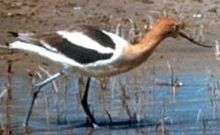
Order: Charadriiformes Family: Recurvirostridae
Recurvirostridae is a family of large wading birds, which includes the avocets and stilts. The avocets have long legs and long up-curved bills. The stilts have extremely long legs and long, thin, straight bills.
- American avocet, Recurvirostra americana LC
- Black-necked stilt, Himantopus mexicanus LC (Hawaiian stilt H. m. knudseni: E)
- Black-winged stilt, Himantopus himantopus (A) LC
Jacanas
Order: Charadriiformes Family: Jacanidae
The jacanas are a group of tropical waders in the family Jacanidae. They are found worldwide within the tropical zone. They are identifiable by their huge feet and claws which enable them to walk on floating vegetation in the shallow lakes that are their preferred habitat.
- Northern jacana, Jacana spinosa LC
- Wattled jacana, Jacana jacana LC
Sandpipers and allies
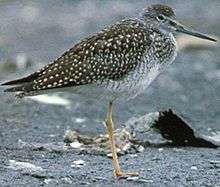
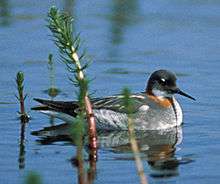
Order: Charadriiformes Family: Scolopacidae
Scolopacidae is a large diverse family of small to medium-sized shorebirds including the sandpipers, curlews, godwits, shanks, tattlers, woodcocks, snipes, dowitchers and phalaropes. The majority of these species eat small invertebrates picked out of the mud or soil. Different lengths of legs and bills enable multiple species to feed in the same habitat, particularly on the coast, without direct competition for food.
- American woodcock, Scolopax minor LC
- Baird's sandpiper, Calidris bairdii LC
- Bar-tailed godwit, Limosa lapponica LC
- Black-tailed godwit, Limosa limosa (A) NT
- Black turnstone, Arenaria melanocephala LC
- Bristle-thighed curlew, Numenius tahitiensis VU
- Broad-billed sandpiper, Calidris falcinellus (A) LC
- Buff-breasted sandpiper, Calidris subruficollis NT
- Common greenshank, Tringa nebularia (A) LC
- Common redshank, Tringa totanus (A) LC
- Common sandpiper, Actitis hypoleucos (A) LC
- Common snipe, Gallinago gallinago LC
- Curlew sandpiper, Calidris ferruginea LC
- Dunlin, Calidris alpina LC
- Greater yellowlegs, Tringa melanoleuca LC
- Eskimo curlew, Numenius borealis (E?) CR E
- Eurasian curlew, Numenius arquata (A) NT
- Eurasian woodcock, Scolopax rusticola (A) LC
- Far Eastern curlew, Numenius madagascariensis (A) VU
- Green sandpiper, Tringa ochropus (A) LC
- Great knot, Calidris tenuirostris (A) VU
- Gray-tailed tattler, Tringa brevipes (A) LC
- Hudsonian godwit, Limosa haemastica LC
- Jack snipe, Lymnocryptes minimus (A) LC
- Least sandpiper, Calidris minutilla LC
- Lesser yellowlegs, Tringa flavipes LC
- Little curlew, Numenius minutus (A) LC
- Little stint, Calidris minuta (A) LC
- Long-billed curlew, Numenius americanus LC
- Long-billed dowitcher, Limnodromus scolopaceus LC
- Long-toed stint, Calidris subminuta (A) LC
- Marbled godwit, Limosa fedoa LC
- Marsh sandpiper, Tringa stagnatilis (A) LC
- Pectoral sandpiper, Calidris melanotos LC
- Pin-tailed snipe, Gallinago stenura (A) LC
- Purple sandpiper, Calidris maritima LC
- Red knot, Calidris canutus LC
- Red-necked phalarope, Phalaropus lobatus LC
- Red-necked stint, Calidris ruficollis LC
- Red phalarope, Phalaropus fulicarius LC
- Rock sandpiper, Calidris ptilocnemis LC
- Ruddy turnstone, Arenaria interpres LC
- Ruff, Calidris pugnax LC
- Sanderling, Calidris alba LC
- Semipalmated sandpiper, Calidris pusilla NT
- Sharp-tailed sandpiper, Calidris acuminata (A) LC
- Short-billed dowitcher, Limnodromus griseus LC
- Solitary sandpiper, Tringa solitaria LC
- Solitary snipe, Gallinago solitaria (A) LC
- Slender-billed curlew, Numenius tenuirostris (E?) CR E
- South American snipe, Gallinago paraguaiae LC
- Spoon-billed sandpiper, Calidris pygmea (A) CR
- Spotted redshank, Tringa erythropus (A) LC
- Spotted sandpiper, Actitis macularius LC
- Stilt sandpiper, Calidris himantopus LC
- Surfbird, Calidris virgata LC
- Temminck's stint, Calidris temminckii (A) LC
- Terek sandpiper, Xenus cinereus (A) LC
- Upland sandpiper, Bartramia longicauda LC
- Wandering tattler, Tringa incana LC
- Western sandpiper, Calidris mauri LC
- Willet, Tringa semipalmata LC
- Whimbrel, Numenius phaeopus LC
- White-rumped sandpiper, Calidris fuscicollis LC
- Wilson's phalarope, Phalaropus tricolor LC
- Wilson's snipe, Gallinago delicata (G. gallinago: LC)
- Wood sandpiper, Tringa glareola LC
Pratincoles
Order: Charadriiformes Family: Glareolidae
Pratincoles have short legs, very long pointed wings and long forked tails. Their most unusual feature for birds classed as waders is that they typically hunt their insect prey on the wing like swallows, although they can also feed on the ground. Their short bills are an adaptation to aerial feeding.
- Collared pratincole, Glareola pratincola (A) LC
- Oriental pratincole, Glareola maldivarum (A) LC
Gulls, terns and skimmers
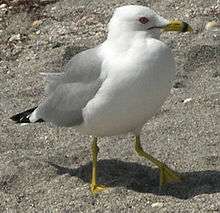
Order: Charadriiformes Family: Laridae
Laridae is a family of medium to large seabirds and includes gulls, terns, kittiwakes and skimmers. They are typically gray or white, often with black markings on the head or wings. They have stout, longish bills and webbed feet.
- Aleutian tern, Onychoprion aleuticus LC
- American herring gull, Larus (argentatus) smithsonianus (L. argentatus: )
- Arctic tern, Sterna paradisaea LC
- Bonaparte's gull, Chroicocephalus philadelphia LC
- Belcher's gull, Larus belcheri (A) LC
- Black-headed gull, Chroicocephalus ridibundus LC
- Black-legged kittiwake, Rissa tridactyla LC
- Black noddy, Anous minutus LC
- Black skimmer, Rynchops niger LC
- Black-tailed gull, Larus crassirostris (A) LC
- Black tern, Chlidonias niger LC
- Bridled tern, Onychoprion anaethetus LC
- Brown noddy, Anous stolidus LC
- California gull, Larus californicus LC
- Caspian tern, Hydroprogne caspia LC
- Mew gull, Larus canus LC
- Common tern, Sterna hirundo LC
- Elegant tern, Thalasseus elegans NT
- Forster's tern, Sterna forsteri LC
- Franklin's gull, Leucophaeus pipixcan LC
- Glaucous gull, Larus hyperboreus LC
- Glaucous-winged gull, Larus glaucescens LC
- Gray gull, Leucophaeus modestus (A) LC
- Great black-backed gull, Larus marinus LC
- Gray-hooded gull, Chroicocephalus cirrocephalus (A) LC
- Gull-billed tern, Gelochelidon nilotica LC
- Heermann's gull, Larus heermanni NT
- Iceland gull, Larus glaucoides (without L. thayeri: LC)
- Inca tern, Larosterna inca (A) NT
- Ivory gull, Pagophila eburnea NT
- Kelp gull, Larus dominicanus LC
- Large-billed tern, Phaetusa simplex (A) LC
- Laughing gull, Leucophaeus atricilla LC
- Least tern, Sternula antillarum LC E (California least tern S. a. browni: E)
- Lesser black-backed gull, Larus fuscus LC
- Little gull, Hydrocoloeus minutus LC
- Red-legged kittiwake, Rissa brevirostris VU
- Ring-billed gull, Larus delawarensis LC
- Roseate tern, Sterna dougallii LC (ssp. dougallii: E or T)
- Ross's gull, Rhodostethia rosea LC
- Royal tern, Thalasseus maximus LC
- Sabine's gull, Xema sabini LC
- Sandwich tern, Sterna sandvicensis LC
- Slaty-backed gull, Larus schistisagus LC
- Sooty tern, Onychoprion fuscatus LC
- Swallow-tailed gull, Creagrus furcatus (A) LC
- Thayer's gull, Larus thayeri LC
- Western gull, Larus occidentalis LC
- Whiskered tern, Chlidonias hybridus (A) LC
- White tern, Gygis alba LC
- White-winged tern, Chlidonias leucopterus (A) LC
- Yellow-billed tern, Sternula superciliaris LC
- Yellow-footed gull, Larus livens LC
- Yellow-legged gull, Larus cachinnans (A) LC
Skuas

Order: Charadriiformes Family: Stercorariidae
Skuas are in general medium to large birds, typically with gray or brown plumage, often with white markings on the wings. They have longish bills with hooked tips and webbed feet with sharp claws. They look like large dark gulls, but have a fleshy cere above the upper mandible. They are strong, acrobatic fliers.
- Great skua, Stercorarius skua LC
- Long-tailed jaeger, Stercorarius longicaudus LC
- Parasitic jaeger, Stercorarius parasiticus LC
- Pomarine jaeger, Stercorarius pomarinus LC
- South polar skua, Stercorarius maccormicki LC
Auks, murres and puffins
Order: Charadriiformes Family: Alcidae
Alcids are superficially similar to penguins due to their black-and-white colors, their upright posture and some of their habits, however they are only distantly related to the penguins and are able to fly. Auks live on the open sea, only deliberately coming ashore to nest.
- Ancient murrelet, Synthliboramphus antiquus LC
- Atlantic puffin, Fratercula arctica LC
- Black guillemot, Cepphus grylle LC
- Cassin's auklet, Ptychoramphus aleuticus LC
- Common murre, Uria aalge LC
- Craveri's murrelet, Synthliboramphus craveri VU
- Crested auklet, Aethia cristatella LC
- Dovekie, Alle alle LC
- Great auk, Pinguinus impennis (E) EX
- Horned puffin, Fratercula corniculata LC
- Kittlitz's murrelet, Brachyramphus brevirostris CR
- Least auklet, Aethia pusilla LC
- Long-billed murrelet, Brachyramphus perdix NT
- Marbled murrelet, Brachyramphus marmoratus EN T
- Parakeet auklet, Aethia psittacula LC
- Pigeon guillemot, Cepphus columba LC
- Razorbill, Alca torda LC
- Rhinoceros auklet, Cerorhinca monocerata LC
- Thick-billed murre, Uria lomvia LC
- Tufted puffin, Fratercula cirrhata LC
- Whiskered auklet, Aethia pygmaea LC
- Xantus's murrelet, Synthliboramphus hypoleucus VU
.jpg)